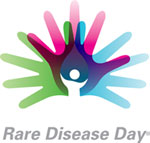 A guest post by Wendy White of Siren Interactive in honor of Rare Disease Day:
A guest post by Wendy White of Siren Interactive in honor of Rare Disease Day:
Can empowered patients drive change in healthcare? Take a look at the progress that has been made in the rare disease community over the last 30 years—much of it spearheaded by patients and caregivers–and I think you’ll agree that the answer is definitely, “Yes!”
In the decade before the Orphan Drug Act was approved in 1983, only 10 new products for rare diseases had been developed by the pharmaceutical industry. Since then, there have been more than 400 drugs and biological products developed for rare diseases.
But there is still much that remains to be done, especially in the area of diagnosis, which is a challenging task for physicians who seldom see rare diseases in their practice. In the first study, conducted by the National Commission on Orphan Diseases in 1989, more than 1/3 of patients reported that it took 5 years to receive an accurate diagnosis after the onset of symptoms. Over twenty years later, the Shire Rare Disease Impact Report found it took an average of 7.6 years to receive an accurate diagnosis in the US—with 2-3 misdiagnoses along the way resulting in inappropriate or delayed treatment.
Mary Dunkle, Vice President of Communications for the National Organization for Rare Disorders (NORD), asked Facebook followers how long they had waited for a diagnosis. One of the comments she received was particularly telling. “It took five years, many tears, and tons of money.”
There are many positive things happening from all corners of the rare disease community to address the challenge of diagnosing rare diseases. The National Organization for Rare Disorders (NORD) is developing a series of disease-specific physician guides. Global Genes recently enhanced their offerings to help undiagnosed patients by partnering with SWAN USA (Syndromes Without A Name) to offer free clinical genomic sequencing testing to rare disease patients who cannot afford costly tests. The National Institutes of Health (NIH) is preparing to expand their Undiagnosed Diseases Program with a network of sites at teaching hospitals around the country. Legislation has also been proposed to fund new initiatives.
Search engines like FindZebra and other new technologies offer the potential to assist physicians with tools that will simplify the task of diagnosing rare diseases. Siren Interactive will be partnering with the author and geneticist, Sharon Moalem, MD, PhD and the Global Genes Project to create a rare disease track at Healthcare’s Grand HackFest with H@cking Medicine at MIT on March 14-16. The hackathon is the final push that will follow more than seven years of research and investments by Dr. Moalem to develop a no-cost facial recognition screening tool for genetic and congenital disorders that leverages technology developed for the security industry.
It will take all stakeholders to address this problem. But once again, empowered patients will be leading the way, advocating for improvements in physician education, finding funding for new centers and new tools, raising awareness of the issues involved and the cost of delayed diagnosis, and supporting each other in their search for a better life for all.
On Rare Disease Day, 2014, we invite you to spread the word about the need to improve Rare Disease Diagnosis by sharing Siren’s infographic, Journey into the Unknown: The Search for a Rare Diagnosis.






Recent Comments